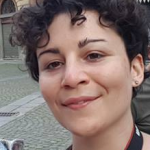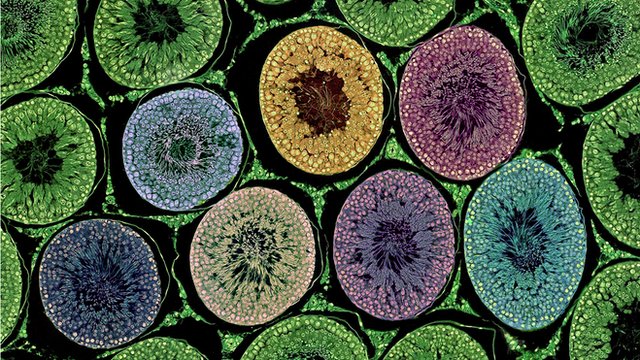In the previous episode, Alice and the biologists started to explore the mysteries of Bio-land together. But what about the land itself? What do we know about the way things happen there, and what about their very nature? For now, we are just wondering and getting lost in our imagination of the place, with al lot of possible paths in front of us. Until, at some point, we unconsciously start to wander…
First of all, approaching Bio-land, we need to ask ourselves a fundamental question: what is life? In which ways are living systems and collections of inanimate objects different? In 1978 James Grier Miller approaches the question articulating his Theory of Living Systems. The concepts of space, time, matter, energy, and information are essential to this theory. In fact biological entities exist in space and are made of matter and energy organized by information. To him, living systems are organised in multiple and nested levels of functioning. At each level, specific subunits behave like open systems, exchanging matter, energy or information between them and the neighbour levels. Subunits dedicated to matter and energy processing can have the function of ingestor, distributor, converter, producer, storage, extruder, motor, or supporter. Subunits handling information instead include input transducers, internal transducers, channels and nets, timers, decoders, associators, memory, decision makers, encoders, and output transducers. Miller tries to capture the continuum of biological complexity by specifying functional details and organisation of living systems. His model allows for cross-layer and cross-system analysis and hypothesis formulation. Yet, Miller’s theory has the main purpose of describing what is already considered to be alive.
There is another interesting approach for dealing with the concept of life. That implies shifting from the generic “what is life?” to the more practical and specific “is it alive?” question. For answering this, it is necessary to check for the presence of all functional features associated with life in the system of interest. The following section recapitulates such criteria.
Organisation and complexity. Living systems are made of compartments separated by semi-permeable membranes capable for selective exchange of information and materials. That generates separate and different biochemical environments within the same system. Specific reactions occur in specialised districts, without affecting other structures. Only some molecules or messages pass through barriers: in this way, different compartments interact in specific ways. Interaction of molecules presuppose their encounter, which is a stochastic event. Spatial organisation and segregation of districts thus alters the interaction probabilities for molecules in different districts. In fact, intra-compartment encounters are way more probable than others, except for selective permeabilities. Compartmentalisation constraints stochastic behaviours of molecules: in living systems complexity emerges, rather than chaos.
The cell is the basic unit. Cells are the smallest units of life capable of independent self-replication. As a primary compartmentalisation instance, a cell presuppose the functional separation of the unitary living system from the external environment. The cell membrane is in fact semi-permeable, allowing for selective exchange of materials and information. The plasma membrane encloses the cytoplasm, where different species of biomolecules are arranged in substructures to different degrees of organisation. In unicellular species, a cell makes an organism by itself, while in pluricellular organisms it constitutes the primary biological building block.
Energy consumption and transformation. Living systems are consumers. They use different forms of energy present in their environment to fulfill their metabolic and structural needs in order to survive and replace their molecular components. They discard what is no more useful for them, giving it back to the environment. But what is waste for an organism can be a resource for another one. In fact, from an ecological point of view, organisms can be rather considered as transformers of resources.
Homeostasis. In a living system some quantitative variables are bounded to a specific range of values in order to guarantee proper functioning of the overall system. Some regulatory mechanisms take care of the situations where such variables drift towards the boundaries of the allowed ranges. Such mechanisms often take the form of buffers, or negative feedback loops. When they fail, the physiological ranges are violated, and a pathological condition arises. The ensemble of dynamic regulations guarding the boundaries of physiology guarantees organismal homeostasis.
Growth and development. Living systems use resources and energy not only to survive and substitute their components, or maintain homeostasis. Individual cells also have the possibility to grow larger in order to divide, forming daughter cells. That makes a form of self-replication for an unicellular organism. In the context of a pluricellular system instead that is usually a form of support to the overall growth of the organism during development, physiological structural renewal, or regeneration of a damaged tissue. A pluricellular organism originally exists in the form of a single cell: the fertilised egg. The overall process giving rise to the adult organism takes the name of ontogenesis, and comprises all developmental and morphogenetic mechanisms across all stages of life, including tissue homeostasis during adulthood.
Reproduction. Living system replicate themselves in different ways involving various degrees of inter-individual exchange of genetic information. That can take many forms, ranging from cloning to sexual reproduction, and involves a variety of secondary mechanisms for regulating or enhancing genomic information inheritance in the offspring.
Response to stimuli. Biological systems react to external stimuli in non deterministic ways. In more complex living systems responses to stimuli take into account information about past events which is stored in dedicated structures. That advanced form of responsivity to the environment represents an instance of learning.
Evolution. On timescales longer than generation times, populations of living organisms adapt to their environment. This process leaves its traces in the shape of information stored in the genome, but selective pressures act at the functional and structural level. By chance, a new feature can emerge from a random genomic mutation. Individuals carrying such feature possibly have an evolutionary advantage, surviving and reproducing more than their peers, that is they are positively selected in a specific environment. That mutation spreads and it is more easily inherited. Darwinian evolution can be seen as a search for new solutions to problems posed by the environment by random generation and non-random, subsequent selection. There is a drawback: mutations are able to determine selective advantages, but also to induce pathology. The price for the generation of fitter individuals is the collateral determination of pathological mutants.
A central theme emerges from these different aspects of living systems: the relation between information, structure and function. Everything in a living system is at least partly made according to a genetic instruction. The genome stores effects of Darwinian evolution. Random genetic mutations generate structural and functional variability, which is the one undergoing selection afterwards.
The current description of the relation between the genome and its realizations in space and time is complex, much farther than the one proposed by the central dogma of molecular biology. Diverse mechanisms regulate qualitatively and quantitatively genomic information usage. In pluricellular and complex organisms such as mammals, it is more suitable to talk about different layers of regulations with flexible hierarchical organisation. Genetic and epigenetic regulations engage into a dynamic interplay involving contribution from the extracellular environment too. Such intricate and dynamic set of mechanisms Is responsible for the emergence of a diversity of cellular phenotypes and structural complexities at the organismal level along ontogenesis. That is another way for describing how living systems use resources from the environment – materials, energy and information – for getting into being, developing, reproducing and adapting.
Biological systems are complex. That emerges because of not only compartmentalisation, but also regulatory networks involving all districts, actors and substrates from each possible -omic pool. Systems biology is the discipline dealing with system-level complexities of living systems. That means dealing with nested networks of networks evolving at many different scales in a multi-level organisation exhibiting cross-layer interactions. Such discipline requires interdisciplinarity, and comprises many approaches ranging from collecting huge amount of experimental data from single biological entitites, to holistic characterisation and theoretical or computational modelling of the overall systems.
Another way of reasoning around life semantics is to consider all things currently considered alive according to scientific knowledge. Despite the human mind apparently has some troubles intuitively classifying the living world, systematic efforts seem to yield way better results. Here you can find an interactive visualization of the tree of life, which groups all known species of living organisms arranging them by genomic similarities.
As a funny note, I conclude this post noticing that the “is it alive?” question is of great interest especially for astrobiologists. In fact, like Alice underlined with her sole presence in Bio-land, at the boundary between different worlds, if not many accurate answers, a lot of interesting questions most often arise. In this case, the philosophical reasoning around these matters extends beyond the limit of our biosphere: would we be able to classify aliveness in a non-terrestrial context? How would our working definitions perform in extremely different physical and chemical enviroments? Would an alien form of life classify us as alive?
 Roberta Bardini
Roberta Bardini
